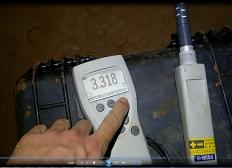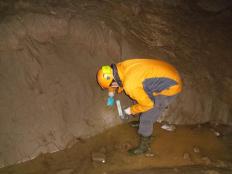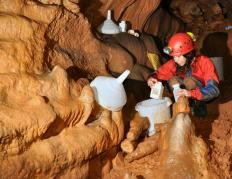Natural resources of karst show caves: a balance among protection, exploitation, and promotion
Project Team
Matej Blatnik, PhD, Franci Gabrovšek, PhD, Martin Knez, PhD, dr. Tadeja Matos, Peter Kozel, PhD, dr. Sanja Stopinšek, dr. Alenka Mauko Pranjić, Andrej Mihevc, PhD, Rok Tomazin, Bojan Otoničar, PhD , Metka Petrič, PhD, Tanja Pipan, PhD , Tadej Slabe, PhD, Stanka Šebela, PhD, Nataša Ravbar, PhD, Nadja Zupan Hajna, PhD, Leon Drame, Franjo Drole, Mateja Zadel, Nadja Zupan Hajna, PhD, Franjo Drole, Leon Drame, Mojca Privšek, Mateja Zadel-
Duration
1 January 2016–31 December 2018 -
SICRIS
SICRIS -
Lead Partner
Research Centre of the Slovenian Academy of Sciences and Arts
-
Project Leader
-
Financial Source
Javna agencija za raziskovalno dejavnost RS

Partners
Slovenian National Building and Civil Engineering Institute, University of Ljubljana, Faculty of Medicine
Caves offer numerous natural resources such as water and construction materials. They are used as shelters, for storage and for medical purposes. They also offer opportunities for scientific studies and education by providing an insight into past geomorphological, ecological and anthropogenic conditions. Among the most common economic activities of cave exploitation is tourism. Its consequent negative effect on cave systems ranges from morphology transformation (e.g. new cave opening, enlargement of passages), climate and chemical processes changes, threats to habitats and similar.
Due to the very slow natural processes towards recovering the natural state, anthropogenic alterations in the underground are virtually everlasting. The past and present utilisation of caves for tourism could be markedly more sustainable if it were more thought-out and in line with scientific guidelines. In line with the Slovenian Cave Protection Act, there is a proposal to arrange the custodianship of show caves that will define the scope and utilisation level as a necessary compromise between preservation and use for tourism. It is also an opportunity to set a sustainable way of utilising existing show caves.
In the frame of the project, existing and new indicators of ecology, geology and climate will be used in order to assess the impact of tourism on the cave environment and on aquatic and terrestrial habitats. The focus lies on the two most popular show caves in Slovenia – the Postojna Cave (Postojnska jama) and Škocjan Caves (Škocjanske jame). The findings about the impact of past and present tourist use, together with the indicators and guidelines, will be valuable for managers of show caves as natural sources, for sustainable cave use and for preparing long-term management plans.
The project is carried out within five interlinked work packages (WP):
WP 1: Characterising the environment of selected cave systems
WP 2: Cave climate – impact of tourism on abiotic parameters
WP 3: Microbiota – parameter to determine anthropogenic pressures
WP 4: Cave fauna – responsiveness to tourist use
WP 5: Dissemination of results
The timeline is summarized by the above table, which shows activities by quarter. Light intensity is appoximately proportional to the intensity of the performance of a specific task; white box means that the task will not be performed.
- Mulec, J., Oarga-Mulec, A. 2016. ATP luminescence assay as a bioburden estimator of biomass accumulation in caves. International Journal of Speleology, 45, 3, 207-218. doi: 10.5038/1827-806X.45.3.1975. [COBISS.SI-ID 40106541];
- Mulec, J., Oarga-Mulec, A. 2016. Stability and dynamics of microbial communities in cave sediments in time and space. In: Abstract book. [Montreal: International Society for Microbial Ecology, 2016]. [COBISS.SI-ID 40164397];
- Mulec, J., Oarga-Mulec, A. 2016. Anaerobiosis in alluvial sediments in karst caves suppress microbial metabolic activities. In: Book of abstracts, 33rd SIL Congress July 31, 2016 - August 5, 2016 Torino, Italy. Torino: SIL, International Society of Limnology, 2016, str. 264-265. [COBISS.SI-ID 40107053];
- Mulec, J., Oarga-Mulec, A., Šturm, S., Tomazin, R., Matos, T. 2017. Spacio-temporal distribution and tourist impact on airborne bacteria in a cave (Škocjan Caves, Slovenia). Diversity, 9, 3, 1-14. doi: 10.3390/d9030028. [COBISS.SI-ID 41852973];
- Jarc, S., Miler, M., Šebela, S., Zupančič, N., .2017 Sources of sulphate minerals in limestone cave-a possible evidence of anthropogenic activity: a case study in Črna Jama Cave (Slovenia). Environmental science and pollution research international:1-9. doi: 10.1007/s11356-017-0486-0. [COBISS.SI-ID 1368670];
- Šebela, S., Turk, J., 2017. Črna Jama as a cold air trap cave within Postojna Cave, Slovenia. Theoretical and applied climatology. doi: 10.1007/s00704-017-2304-5. [COBISS.SI-ID 42090285];
- Šebela, S., Zupančič, N., Miler, M., Grčman, Helena, Jarc, S. 2017. Evidence of Holocene surface and near-surface palaeofires in karst caves and soils. Palaeogeography, palaeoclimatology, palaeoecology,1- 12. doi: 10.1016/j.palaeo.2017.06.015. [COBISS.SI-ID 1345886];
- Mulec, J. 2017. Microbiota in caves: contribution from Classical Karst to global knowledge of underground microbiome. V: Gostinčar, P (ur.). Milestones and challenges in karstology: abstracts & guide book. 25th International Karstological School "Classical Karst", Postojna, 2017, Ljubljana, Založba ZRC, 42. [COBISS.SI-ID 41759277];
- Oarga-Mulec, A., Holko, L., Kopitar, A.N., Mulec, J. 2017. Study of water cycle in karst with chemical and microbiological parameters. V: Gostinčar, P. (ur.). Milestones and challenges in karstology: abstracts & guide book. 25th International Karstological School "Classical Karst", Postojna, 2017, Ljubljana, Založba ZRC, 43-44. [COBISS.SI-ID 41760301];
- Mulec, J. 2017. Vloga in pomen mikroorganizmov v Škocjanskih jamah. 2017. Proteus: ilustriran časopis za poljudno prirodoznanstvo. 79, 7/8/9, 340-352 [COBISS.SI-ID 64879714];
- Tomazin, R., Simčič, S., Matos, T., Kopitar, A.N., Stopinšek, S., Mauko Pranjić, A., Zalar Serjun, V., Mulec, J. 2018. Vpliv turizma na kakovost zraka v Postojnski jami in Škocjanskih jamah. V: Petrovec, M. (ur.). Mikrobiologija v javnem zdravstvu. Ljubljana, Sekcija za klinično mikrobiologijo in bolnišnične okužbe SZD, 105-116. [COBISS.SI-ID 43935789];
- Mulec, J. 2018. A monitoring plan using microbiological indicators to balance protection and exploitation of major tourist caves in Slovenia. V: Prelovšek, M. (ur.). Show caves and science: abstracts & guide book. 26th International Karstological School "Classical Karst", Postojna, 2018, Ljubljana, Založba ZRC, 82-83 [COBISS.SI-ID 43385645];
- Oarga-Mulec, A., Štefančič, M., Zalar Serjun, V., Mauko Pranjić, A., Mulec, J. 2018. Microbial activity in alluvial sediment in the Reka River (Škocjan Caves, Slovenia). V: Prelovšek, M. (ur.). Show caves and science: abstracts & guide book. 26th International Karstological School "Classical Karst", Postojna, 2018, Ljubljana, Založba ZRC, 84-85 [COBISS.SI-ID 43376685];
- Tomazin, R., Simčič, S., Matos, T., Kopitar, A.N., Stopinšek, S., Mauko Pranjić, A., Zalar Serjun, V., Mulec, J. 2018. Tourists impact on air quality in Postojna Cave and Škocjan Caves (Slovenia). V: Prelovšek, M. (ur.). Show caves and science: abstracts & guide book. 26th International Karstological School "Classical Karst", Postojna, 2018, Ljubljana, Založba ZRC, 95 [COBISS.SI-ID 43381293];
- Kozel, P., Mulec, J., Pipan, T., Prelovšek, M. 2018. Afternoon field trip (A): Postojna Cave System: Tuesday, 19th June 2018, 15:00-20:00. V: Prelovšek, M. (ur.). Show caves and science: abstracts & guide book. 26th International Karstological School "Classical Karst", Postojna, 2018, Ljubljana, Založba ZRC, 14-21 [COBISS.SI-ID 43363885];
- Prelovšek, M., Mulec, J. 2018. Afternoon field trip (B): M and [micro] show caves: Wednesday, 20th June 2018, 14:00-19:15. V: Prelovšek, M. (ur.). Show caves and science: abstracts & guide book. 26th International Karstological School "Classical Karst", Postojna, 2018, Ljubljana, Založba ZRC, 22-28 [COBISS.SI-ID 43364397];
- Prelovšek, M. 2018 Impact of anthropogenic CO2 increase on speleothem deposition. V: Prelovšek, M. (ur.). Show caves and science: abstracts & guide book. 26th International Karstological School "Classical Karst", Postojna, 2018, Ljubljana, Založba ZRC, 88-89 [COBISS.SI-ID 43378477];
- Pipan, T., Petrič, M., Šebela, S., Culver, D.C. 2018. Analyzing climate change and surface-subsurface interactions using the Postojna Planina Cave System (Slovenia) as a model system. Regional environmental change, 19, 2, 379-389. doi: 10.1007/s10113-018-1349-z. [COBISS.SI-ID 42929197];
- Prelovšek, M., Šebela, S., Turk, J. 2018. Carbon dioxide in Postojna Cave (Slovenia): spatial distribution, seasonal dynamics and evaluation of plausible sources and sinks. Environmental earth sciences, 77, 7, 1-15. doi: 10.1007/s12665-018-7459-6. [COBISS.SI-ID 42840877]
- Mulec, J., Petrič, M., Koželj, A., Brun, C., Batagelj, E., Hladnik, A., Holko, L. 2019. A multiparameter analysis of environmental gradients related to hydrological conditions in a binary karst system (underground course of the Pivka River, Slovenia). Acta carsologica, 48, 3, 313-327. doi: 10.3986/ac.v48i3.7145. [COBISS.SI-ID 45577517]








